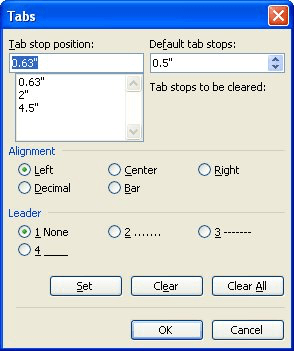Please Note: This article is written for users of the following Microsoft Word versions: 97, 2000, 2002, and 2003. If you are using a later version (Word 2007 or later), this tip may not work for you. For a version of this tip written specifically for later versions of Word, click here: Deleting All Tab Stops.
Written by Allen Wyatt (last updated July 10, 2021)
This tip applies to Word 97, 2000, 2002, and 2003
Joan is looking for the quickest way to delete all of the tab stops in a Word document. She wonders, specifically, if there is a keyboard shortcut that will do it.
There is no keyboard shortcut to remove tab stops—you must use the Tabs dialog box to accomplish the task. While you can use the keyboard to call up the Tabs dialog box and make selections within it, doing so doesn't technically count as a "keyboard shortcut." Here is the quickest way to delete all tab stops:

Figure 1. The Tabs dialog box.
Some have suggested that a quick way to delete tab stops is to simply select all the text (Ctrl+A) and then press Ctrl+Q. What this does is to remove all explicit paragraph formatting from the text. While it is true that the tab stops are a paragraph format, Ctrl+Q just removes any explicitly added tab stops; it sets the paragraphs back to whatever formatting is defined for each paragraph's style. So if the underlying paragraph style has tab stops defined, then those tab stops remain after Ctrl+Q is pressed—not all tab stops are removed.
If you need to remove the tab stops from a large number of documents, then you may want to use a macro to do the job. The following single-line macro removes all the tab stops from all paragraphs in the current document:
Sub TabsGone()
ActiveDocument.Paragraphs.TabStops.ClearAll
End Sub
You should understand two things about this discussion. First, deleting all tab stops doesn't get rid of any of the tab characters in the document. The best way to get rid of those is to use Word's Find and Replace capabilities.
Second, when you get rid of tab stops, Word's default tab stops automatically come into play. By design, the default tab stops are every half-inch, although you can change the default tab stop settings as described in other issues of WordTips. What you cannot do, however, is get rid of the default tab stops; there is no way to do this.
Note:
WordTips is your source for cost-effective Microsoft Word training. (Microsoft Word is the most popular word processing software in the world.) This tip (10190) applies to Microsoft Word 97, 2000, 2002, and 2003. You can find a version of this tip for the ribbon interface of Word (Word 2007 and later) here: Deleting All Tab Stops.

Do More in Less Time! An easy-to-understand guide to the more advanced features available in the Microsoft 365 version of Word. Enhance the quality of your documents and boost productivity in any field with this in-depth resource. Complete your Word-related tasks more efficiently as you unlock lesser-known tools and learn to quickly access the features you need. Check out Microsoft 365 Word For Professionals For Dummies today!
Tabs don't normally show up in your printed document, but Word allows you to still search for them. All you need to do is ...
Discover MoreWord offers a variety of tabs that define different ways to align text. If you need to align numeric values, you'll ...
Discover MoreMost people use the mouse to set tab stops in the paragraphs in a table. If you prefer to not use the mouse, then you'll ...
Discover MoreFREE SERVICE: Get tips like this every week in WordTips, a free productivity newsletter. Enter your address and click "Subscribe."
There are currently no comments for this tip. (Be the first to leave your comment—just use the simple form above!)
Got a version of Word that uses the menu interface (Word 97, Word 2000, Word 2002, or Word 2003)? This site is for you! If you use a later version of Word, visit our WordTips site focusing on the ribbon interface.
Visit the WordTips channel on YouTube
FREE SERVICE: Get tips like this every week in WordTips, a free productivity newsletter. Enter your address and click "Subscribe."
Copyright © 2026 Sharon Parq Associates, Inc.
Comments